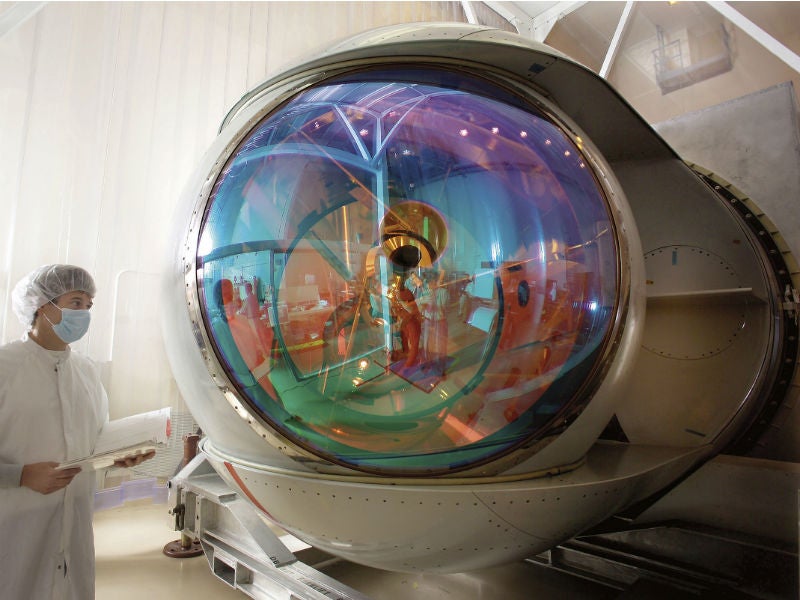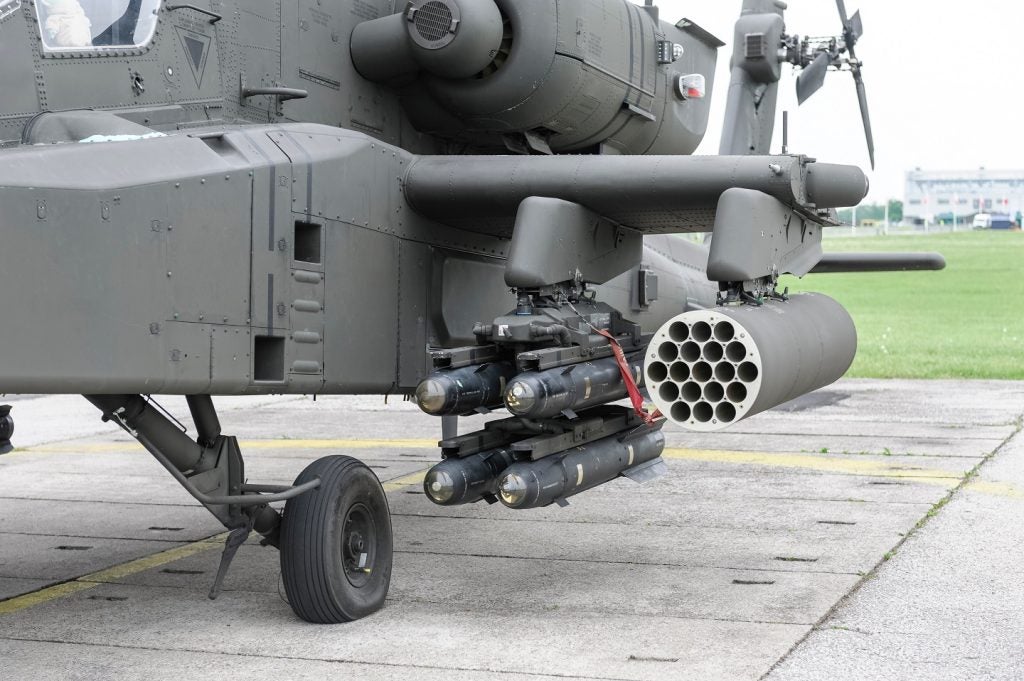
In just a few years’ time US war fighters will have direct energy weaponry in their arsenals, according to the US Department of Defense (DoD). To achieve this the US has committed to increasing investment in these systems, which utilise non-kinetic energy to deliver lethal fluence on targets, for missile defence. The aim is to ultimately develop a space-based defence system – a major achievement, should it succeed.
Space-based missile defence
A space-based laser weapon defence capability has been the long-term goal for the US, and others, for many years. “If you deploy a space-based interceptor constellation, which is something we’ve studied in excess of 30 years, I think the effectivity is beyond doubt, it’s not technically hard to do,” Michael Griffin, undersecretary of defence research and engineering, told reporters in August 2018.
Speaking at a media roundtable at the Space and Missile Defense Symposium, he said although not being “right around the corner”, such a system wasn’t out of reach, but would require a “substantial policy shift”.
Having had some previous success in shooting down a missile with direct energy, the Pentagon is weighing up a number of options, including using manned aircraft such as F-15s or F-35s, unmanned aerial vehicles (UAVs) flying at a higher altitude, or a space-based system. Each have their pros and cons, but Griffin suggested space would be his favoured option for boost phase interception.
The aim is to develop and deploy a laser weapon capable of operating at high altitude and with long endurance by 2023. A laser-equipped HALE drone would be operating around sites of interest, ready to shoot down ballistic missiles at the boost phase. That’s the concept at least, supported by $563m of investment across a number of research programmes.
Laser weapon challenges
However, writing for Arms Control Now, the Arms Control Association’s director for disarmament and threat reduction policy Kingston Reif and American University undergraduate Ryan Fedasiuk said: “Despite the many pitfalls of directed energy weapons, it is unlikely that the Missile Defense Agency (MDA) will soon relinquish the chase for laser defence. But one thing is certain: the road ahead will be difficult and costly.” The pair identified three challenges: precision tracking, beam control, and power scaling.
How well do you really know your competitors?
Access the most comprehensive Company Profiles on the market, powered by GlobalData. Save hours of research. Gain competitive edge.

Thank you!
Your download email will arrive shortly
Not ready to buy yet? Download a free sample
We are confident about the unique quality of our Company Profiles. However, we want you to make the most beneficial decision for your business, so we offer a free sample that you can download by submitting the below form
By GlobalData“At the heart of MDA’s directed energy weapon problem is lowering the ratio of size, weight, and power in a laser system,” they said. “The laser designators on MDA’s active tracking systems, which belong to the Multispectral Targeting System family of sensors, have not demonstrated anything close to an extended range laser range finding capability.”
They added that problem was “jitter” – vibration and other movements which lead to the laser light jumping while shinning on its target. “To be effective, a laser must bore into a single spot for several seconds until the target is destroyed,” they continued.
Laser competition is strong
The US military and its commercial partners are working to address these problems and improve the capabilities of direct energy weapons.
Among them is Raytheon. “Drawing on decades of manufacturing expertise, Raytheon continues to define the future for high energy laser systems, target designators, and next-generation laser range finders,” the company says.
Raytheon has good reason to boast about its work, which dates back more than six decades. The company produced what it says were the first laser range-finders, the first laser target designator, and the first military-grade LADAR surveying method, a combination of radar and laser.
Among its successes in 2018, Raytheon worked with the US Army Apache Programme Management Office and US Special Operations Command to hit an unmanned target on the ground with a high energy laser mounted on an Apache AH-64 attack helicopter. Following the exercises the company said it had collected data on vibration.
Later in the year, during a US Army-led exercise, Raytheon’s advanced high power microwave and laser dune buggy managed to take down 45 unmanned aerial vehicles and drones.
Raytheon advanced missile systems vice president Dr Thomas Bussing said: “The speed and low cost per engagement of directed energy is revolutionary in protecting our troops against drones. We have spent decades perfecting the high power microwave system, which may soon give our military a significant advantage against this proliferating threat.”
Lockheed raises the game
Raytheon had been locked in battle with other major player, Lockhead Martin, to secure a US Army contract to develop a 100-kilowatt laser for its family of Medium Tactical Vehicles. Lockheed Martin, in collaboration with Dynetics and others, won out.
Iain McKinnie, Lockheed Martin business development lead for advanced laser solutions and strategy, says: “The proliferation of hostile unmanned aerial systems and rockets, artillery and mortars present an increasing threat to deployed US troops. Laser weapons offer a deep magazine and very low cost per shot making them ideally suited to complement existing kinetic energy weapons to address intense UAS swarms and RAM raids.”
Lockheed Martin Space is also working on developing direct energy potential. “For 40 years, Lockheed Martin has researched, designed, developed, and captured electromagnetic energy and elevated its power to create innovative directed energy solutions for air, ground, and sea platforms,” says Sarah Reeves, vice president of missile defence programmes. The company has a long pedigree in intercontinental ballistic missiles, having developed the first known one in the late 1950s.
With that heritage and its ongoing work in target identification and countermeasures, its Space-Based Infrared Surveillance (SBIRS) programme, and its laser weapon prototype, Advanced Test High Energy Asset system (ATHENA), the company is well placed to help address the challenges posed by the DoD to offer boost phase interception from space.
“Lockheed Martin is working with various customers on advanced, state-of-the-art, military ready systems for various multiple missions. Though technical and engineering challenges remain, design optimisation is underway as we continue to lower technical risk at our California facilities,” says Reeves.
ATHENA is a mobile system designed to counter close in, low value threats such as improvised rockets, unmanned aerial systems, vehicles, and small boats. It uses the company’s Accelerated Laser Demonstration Initiative spectral beam and multiple fibre laser modules. Together they form a “single, powerful, high-quality beam, providing great efficiency and lethality in a design that scales to higher power levels”, according to Lockheed Martin.
“Directed energy systems present an opportunity to flip the cost curve as we currently see it today,” continues Reeves. “We are addressing critical operational needs to include: accuracy, mobility, size, weight and power, cooling, and minimise collateral damage.”
Directed energy in space – can it really be done?
The MDA is already well aware of the concerns raised by Reif and Fedasiuk in their Arms Control Now article. In 2017, the agency’s deputy director Jon Hill had said the MDA faced three barriers in its mission to develop direct energy weapons: tracking, beam control, and power scaling. It seems these barriers are now getting the attention they need.
“Directed energy provides a significant advantage evolutionary path, in some scenarios, to get away from shooting down expensive missiles with more expensive interceptors. By utilising it we have the ability to drastically lower the cost per engagement,” says Reeves.
As Griffin said, it is very easy to see direct energy weapons being used in the battle space very soon, but their use in space is still a concept far from reality. Even though the DoD is keen to be able to intercept missiles in early flight, it’s possible the land and air options may win out for the time being.







